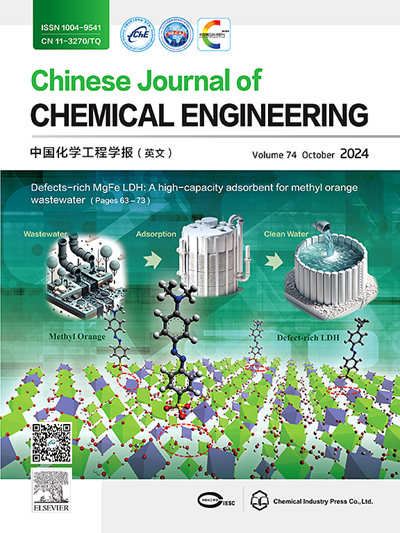新型TEPA/DEEA双相吸收体捕集CO2的实验及其相变机理
IF 3.7
3区 工程技术
Q2 ENGINEERING, CHEMICAL
引用次数: 0
摘要
随着化学吸收剂的发展,双相吸收剂在吸收性能和能耗方面具有很大的潜力。本文研究了一种由四乙烯五胺(TEPA)和二乙基乙醇胺(DEEA)组成的新型双相吸收剂来捕获二氧化碳。通过正交实验找到了合适的分层边界。通过正交试验确定了最佳的CO2捕集条件。影响CO2吸收能力和速率的因素排序为C(废液流率)>;A(质量比)>;B(反应温度)。在140℃下,新型双相吸收剂的解吸效率达到96.66%。新型双相吸收剂具有良好的可回收性,其能耗为2.23 GJ·t−1 CO2。通过粘度实验,13C NMR数据分析反应产物,FT-IR数据分析官能团和化学键,CO2的吸收和相变机理遵循两性离子机理。这是一种值得深入研究的双相胺。本文章由计算机程序翻译,如有差异,请以英文原文为准。
Experiment on a new biphasic absorber composed of TEPA/DEEA for capturing CO2 and its phase transition mechanism
With the development of chemical absorbers, biphasic absorbers have the potential for absorption performance and energy consumption. In this work, a new biphasic absorber composed of tetraethylene pentamine (TEPA) and Diethyl ethanolamine (DEEA) is formed to capture CO2. The appropriate stratification boundaries by experimentation are found for orthogonal experiment. The optimum capture CO2 conditions are obtained according to the orthogonal design. The ranking of factors affecting the ability and rate to absorb CO2 is C (waste flow rate) > A (mass ratio) > B (reaction temperature). The desorption efficiency of the new biphasic absorber reaches 96.66% at 140 °C. The new biphasic absorber has good recyclability and its energy consumption is 2.23 GJ·t−1 CO2. Through viscosity experiment, reaction products analyzed by 13C NMR date, functional groups and chemical bonds analyzed by FT-IR date analysis, the mechanisms of CO2 absorption and phase transition follow a zwitterionic mechanism. This is a biphasic amine that deserves in-depth study.
求助全文
通过发布文献求助,成功后即可免费获取论文全文。
去求助
来源期刊

Chinese Journal of Chemical Engineering
工程技术-工程:化工
CiteScore
6.60
自引率
5.30%
发文量
4309
审稿时长
31 days
期刊介绍:
The Chinese Journal of Chemical Engineering (Monthly, started in 1982) is the official journal of the Chemical Industry and Engineering Society of China and published by the Chemical Industry Press Co. Ltd. The aim of the journal is to develop the international exchange of scientific and technical information in the field of chemical engineering. It publishes original research papers that cover the major advancements and achievements in chemical engineering in China as well as some articles from overseas contributors.
The topics of journal include chemical engineering, chemical technology, biochemical engineering, energy and environmental engineering and other relevant fields. Papers are published on the basis of their relevance to theoretical research, practical application or potential uses in the industry as Research Papers, Communications, Reviews and Perspectives. Prominent domestic and overseas chemical experts and scholars have been invited to form an International Advisory Board and the Editorial Committee. It enjoys recognition among Chinese academia and industry as a reliable source of information of what is going on in chemical engineering research, both domestic and abroad.
 求助内容:
求助内容: 应助结果提醒方式:
应助结果提醒方式:


